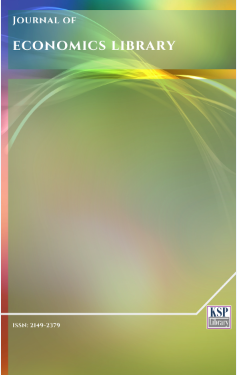Leaning against the wind: Effects of macroprudential policy on sectoral
Abstract
Abstract. Use of macroprudential policies in recent years has gained relevance in different economies. As a result of the financial crisis in 2008, this instrument was useful in emerging economies to reduce the effects of the adverse international context. The relationship between financial intermediation and the real sector is positive, in response to shocks in productive credit the sectoral growth is 0.15pp in 2016. Likewise, the modification of the reserve requirement rate can provide or with draw liquidity from the financial system, in the first case, the objective is to increase portfolio placement, which affects the development of productive sectors. Therefore, there is a need to evaluate the effect of changes in the reserve requirement rateon sectoral growth in Bolivia, which was offset by the financial cycle because episodes of Credit Crunch affect the real sector (the economic cycle is amplified to the downside). The methodologies used are the Fixed Effects (FE), Random Effects (RA) and Panel Autoregresive Vectors (Panel-VAR) and recursive versions of them. The positive effects of the macroprudential policy and changes in the position that this instrument had over time, depending on the financial cycle, Leaning Against the Wind. Reserve requirement ratedecreasesof the national currency has positive impact on sectoral growth and tests with recursive versions shows positive effects and increase of credit towards the sectoral activity.
Keywords. Reserve requirements, Interest rate, Fixed effects (EF), Random effects (RE), Panel VAR, Recursive estimation, Leaning against the wind.
JEL. C50, E51, E52.Keywords
References
Abrigo, M., & Love, I. (2015). Estimation of panel vector autoregression in stata: a Package of programs. Working Paper. [Retrieved from].
Baltensperger, E. (1982). Reserve requirements and economic stability. Journal of Money, Credit and Banking. 14(2), 205-215. doi. 10.2307/1991639
Fama, E. (1985). What is different about banks. Journal of Monetary Economics, 15(1), 29-39. doi. 10.1016/0304-3932(85)90051-0
Fendoglu, S. (2017). Credit cycles and capital flows: Effectiveness of the macroprudential policy framework in emerging market economies. Journal of Banking and Finance, 79, 110-128. doi. 10.1016/j.jbankfin.2017.03.008
Goldberger, A. (1968). The interpretation and estimation of Cobb-Douglas functions. Econometrica, 36(3/4), 464-472. doi. 0012-9682(196807/10)36:3/4<464:TIAEOC>2.0.CO;2-X
Gray S. (2011). Central bank balances and reserve requiriments. IMF Working Papers, No.WP/11/36. [Retrieved from].
Hansen, L.P. (1982). Large sample properties of generalized method of moments estimators, Econometrica, 50(4), 1029-1054. doi. 10.2307/1912775
Harding, D. & Pagan, A. (2002). Dissecting the cycle: A methodological investigation. Journal of Monetary Economics, 49(2), 365-381. doi. 10.1016/S0304-3932(01)00108-8
Holtz-Eakin, D., Newey, W., & Rosen, H.S. (1988). Estimating vectorautoregressions with panel data. Econometrica, 56(6), 1371-1395. doi. 0012-9682(198811)56:6<1371:EVAWPD>2.0.CO;2-V
Kennedy, P. (1981). Estimation with correctly interpreted dummy variables in semilogarithmic equations. The American Economic Review, 71(4), 801.
Loungani, P., & Rush, M. (1995). The effect of changes in reserve requirements on investment and GNP. Journal of Money, Credit and Banking, 27(2), 511-526. doi. 10.2307/2077881
Montoro, C. (2011). Assessing the role of reserve requirements under financial frictions. Preliminary draft, March.
Montoro, C., & Moreno, R. (2011). Los requerimientos de encaje como instrumento de política en América Latina. Versión en español de: The use of reserve requirements as 36 a policy instrument in Latin America. BIS Quarterly Review, March, 53-65.
Moreno, R. (2011). La formulación de políticas desde una perspectiva “macroprudencial” en economías de mercado emergentes. Banco de Pagos Internacionales. [Retrieved from].
Romer D. (1985). Financial intermediation, reserve requirements, and inside money: A general equilibrium analysis. Journal of Monetary Economics, 16(2), 175-194. doi. 10.1016/0304-3932(85)90029-7
Silver Mick (2016). How to better measure hedonic residential property price indexes. IMF Working Papers, No.WP/16/213. [Retrieved from].
Tovar, C.E., Garcia-Escribano, M., & Martin, M.V. (2012). Credit growth and the effectiveness of reserve requirements and other macroprudential instruments in Latin America, IMF Working Papers, No.WP/12/142. [Retrieved from].
Walsh, C. (2012). Discussion of reserve requirements for price and financial stability: When are they effective?". International Journal of Central Banking, 8(2), 115-126.
Zhang, L., & Zoli, E. (2014). Leaning against the wind: Macroprudential policy in Asia. IMF Working Papers, No.WP/14/22. [Retrieved from].DOI: http://dx.doi.org/10.1453/jel.v6i4.2001
Refbacks
- There are currently no refbacks.
.......................................................................................................................................................................................................................................................................................................................................
Journal of Economics Library - J. Econ. Lib. - JEL - www.kspjournals.org
ISSN: 2149-2379
Editor: [email protected] Secretarial: [email protected] Istanbul - Turkey.
Copyright © KSP Library

